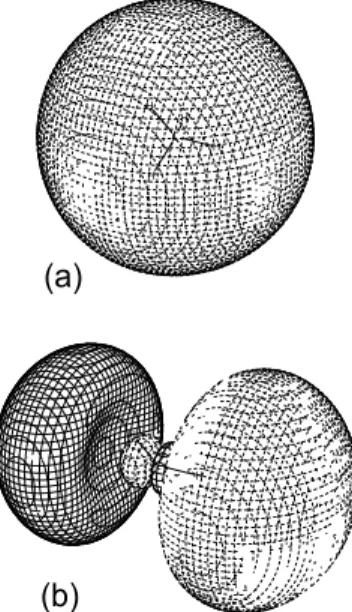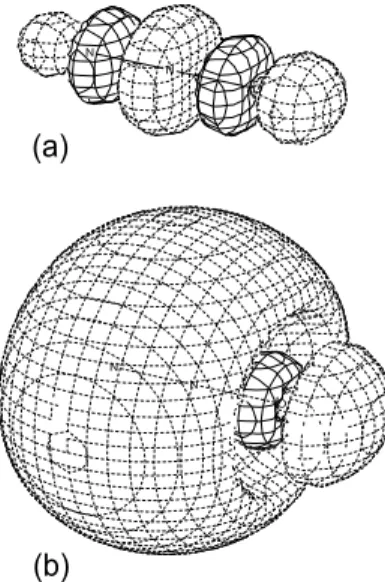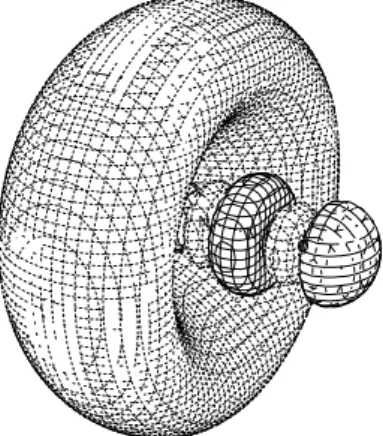Brazilian Journal of Physics, vol. 35, no. 4A, December, 2005 957
Orbital Picture in Molecular Inner-Shell Excited States
of Rydberg-Valence Mixed Character
Nobuhiro Kosugi
UVSOR, Institute for Molecular Science, Myodaiji, Okazaki 444-8585, Japan
Received on 14 January, 2005
The core-to-σ* excited state is repulsive for the bond elongation; on the other hand, the core ionized state and the core-to-π* state are bound and the core-to-Rydberg states are almost parallel to the potential energy curve of the core ionized state. Thus, the core-electron excitation to the unoccupiedσ* orbital can be mixed with the one-electron Rydberg or continuum orbital, as dependent on the bond distance, and even with the unoccupiedπ* orbital in some cases. Within the framework of one-electron picture, we showσ* orbitals mixed with Rydberg character in the 1s excitation of O2 and CH3F, and Rydberg orbitals mixed with valence character in the 1s excitation of CH4, CO2, and N2O.
I. INTRODUCTION
The atomic and molecular core-to-Rydberg excitation is converging to a certain core ionization threshold (Eth). In ad-dition, most molecules have unoccupied molecular orbitals of anti-bonding valence character such asσ* andπ*. These anti-bonding orbitals can also accept an excited electron from the inner shell. The potential energy curve of the core-to-σ* va-lence excited state [1] is repulsive for a specifiedσbond; then, the core-to-σ* excited state is lower than the continuum and Rydberg region at the longer bond distance and is embedded in the continuum at the shorter distance. That is, two kinds of interaction involving the valence state should be discussed along the potential energy curve for a specified σ bond[1]: the Rydberg-valence interaction below Ethand the continuum-valence interaction above Eth. In the present work, we discuss the former interaction within one-electron picture and show how the valence and/or Rydberg orbitals look like through the interactions.
II. RYDBERG CONTRIBUTION IN CORE-TO-σ* EXCITATION
A. O2
N2has a triple covalent bond and the 3σu* molecular or-bital is of strong antibonding character; then, the N1s excita-tion to thisσ* orbital is observed above Ethas a well-known shape resonance. In molecules having weak covalent bonds, the 1s→σ* excited state is possibly observed below Eth. We can expect Rydberg-valence (RV) mixings in the case of the same p-symmetry as the 2pσ* orbital. As already discussed [1,2], the strong RV mixing results in new potential energy curves due to the avoided curve crossing of the Rydberg (p-type) and valence (2pσ*) states.
The Rydberg features in the O 1s excitation spectrum of O2 with a triplet ground state (3Σ+g) are very complicated due to two ionization thresholds, 4Σ+ and 2Σ+ [2,3]. The
angle-resolved photoion spectroscopy (ARPIS) has shown that the core-to-σ* (3σu*) excited states give exchange-split
two strong resonances in the Rydberg region [2,3] and that the4Σ+channel gives vibrational enhancements in the 3pσ Rydberg state and the2Σ+channel has no distinct evidence for the RV mixing [2]. Fig. 1 shows (a) this 3σu* orbital be-fore the RV mixing and (b) the RV-mixed 3pσ-3σu* orbital in the Franck-Condon region. This kind of the RV mixing is not effective for the s-type or d-type Rydberg states with different symmetry from the 2pσ* orbital.
O O
O O
(b) (a)
FIG. 1: Contour maps of (a) the 3σu* orbital obtained before the RV mixing (without any diffuse function) and (b) the RV-mixed 3pσ -3σu* orbital in the O1s excitation of O2.
B. CH3F
958 Nobuhiro Kosugi
C F H
H H C
F H
H H
(b) (a)
FIG. 2: Contour maps of (a) theσ* (6a1*) orbital and (b) the 3sa1 Rydberg orbital in the C1s excitation of CH3F.
III. VALENCE CONTRIBUTION IN CORE-TO-RYDBERG EXCITATION
A. CH4
A simple molecular orbital picture predicts that the CH4 molecule has the 2t2* and 3a1* antibonding mole-cular orbitals. In the case of inner-shell excitation, the C1s (1a1)→3a1 excitation is dipole forbidden but the C1s (1a1)→2t2 excitation is dipole allowed. However, no
dis-tinct 2t2* resonance is observed in the C1s photoabsorption of CH4[5]. The C1s photoabsorption spectrum shows many distinct Rydberg states, vibronically allowed 3sa1, strong npt2 series, and ndt2 series. The Rydberg region in CH4 (C1s) [5] seems to be almost the same as in CH3F (C1s) [4]. It is noticed that the C1s (1a1)→3pt2Rydberg excited state with three-fold degeneracy should be affected by Jahn-Teller (JT) distortion. Fig. 3 shows one of the three degenerate 3pt2 Ry-dberg orbitals in CH4in comparison with the 3sa1 Rydberg orbital. Considering that the 3pt2orbital has no valence con-tribution and is purely atomic-like, we could expect a very weak JT distortion in the 3pt2Rydberg state [6]. However, re-cent high-resolution C1s photoabsorption spectra of CH4[7,8] have shown that the 3pt2Rydberg state shows strong tional contributions in addition to the total symmetric vibra-tion. This vibrational enhancement should arise from the JT effect in CH4. Fig. 4 shows (b) a C3v-distorted 3p Rydberg orbital, together with (a) the 2t2* orbital obtained without any diffuse function. The JT distorted 3pt2orbital can get a large 2t2* contribution. This valence mixing gives intensities to the vibronically excited states of the C1s (1a1)→3pt2excitation.
C H H
H H
C H H
H H
(b)
(a)
FIG. 3: Contour maps of (a) the 3sa1Rydberg orbital and (b) one of the three 3pt2 Rydberg orbitals in the C1s excitation of CH4. The 3pt2orbital has no valence contribution and is purely atomic-like.
C H H
H H
C H H
H H
(b) (a)
FIG. 4: Contour maps of (a) the 2t2* orbital obtained without any diffuse function and (b) a C3v-distorted “3pt2” orbital in the C1s ex-citation of CH4. The 2t2* valence mixing gives intensities to the vibronically excited states of the C1s (1a1)→3pt2excitation.
B. CO2(C1s)
bend-Brazilian Journal of Physics, vol. 35, no. 4A, December, 2005 959
ing motion in terms of molecular dynamics, is related to the vibronically induced 3sσg Rydberg transition. In high-resolution ARPIS spectra, bending vibrational fine structures are resolved in the C1s (2σg)→3sσgand 4sσgRydberg bands [8,9].
C O O
C O O
(b) (a)
FIG. 5: Contour maps of (a) the 5σg* valence orbital obtained with-out any diffuse function and (b) the 3sσgRydberg orbital in the C1s (2σg)excitation of CO2.
C O O
C O O
(b)
(a)
FIG. 6: Contour maps of (a) theπ* orbital and (b) the 3s Rydberg orbital at a bent geometry in the C1s excitation of CO2. The 3s Ryd-berg orbital has a largeπ* valence contribution.
C. N2O and CO2(terminal N and O)
N2O and CO2are isoelectronic and the molecular orbitals look similar. The lowestσ* (8σ*) and 3s Rydberg orbitals excited from the central N (Nc)are shown in Fig. 7. The or-bital character is nearly the same as in CO2(C1s) shown in Fig. 5. The Nc1s excitation of N2O is expected to be similar to the C1s excitation of CO2. Unfortunately, the N1s excita-tion spectra include contribuexcita-tions from two N 1s edges and do not show clear evidence for bending mode coupling in the Nc manifold [11]. On the other hand, the lowestσ* orbitals (8σ* of N2O in Fig. 7(a) and 5σg* of CO2in Fig. 5(a)) have a large pσcomponent on the terminal N (Nt)and O. Fig. 8 shows a contour map of the “4s” Rydberg orbital excited from the Nt 1s. The Nt 4s Rydberg orbital has a large 8σ* contri-bution with a pσcomponent as shown in Fig. 7(a) and get its intensity from the Nt1s→pσcomponent [1,11]. Although the
s-type Rydberg series is generally expected to be weak in the 1s photoabsorption, the Rydberg regions of the Nt1s and O1s excitations of N2O and CO2are dominated in the observed spectra [7,8,11] by the s-type Rydberg states (4s most domi-nant) due to the lowestσ* mixing with the pσcomponent on the terminal atoms. However, it is noted that the 1s→8σ* ex-citation of N2O and 1s→5σg* excitation of CO2are not def-initely identified as the 1s→2t2* of CH4. In these cases, it is reasonable to think that the valence contribution is dissolved in the Rydberg sea [1,6,12].
N N
O
N N
O
(b) (a)
FIG. 7: Contour maps of (a) the lowestσ* (8σ*) orbital obtained without any diffuse function and (b) the RV-mixed 3sσorbitals in the central N (Nc)1s excitation of N2O.
IV. SUMMARY
960 Nobuhiro Kosugi
N N
O
FIG. 8: A contour map of the RV-mixed 4sσorbital in the terminal Nt1s excitation of N2O.
photoabsorption spectra of CH4, CO2, and N2O. In the for-mer molecules, the excitation to theσ* orbital is identified in the Franck-Condon region from the ground state; in the latter molecules, the excitation to theσ* orbital is not clearly identi-fied but its evidence is observed through the Rydberg-valence mixing in the Franck-Condon region. In O2, theσ* (3σu*)
orbital is mainly mixed with the 3pσu Rydberg orbital con-verging to the4Σ+(4Σ+
g)ionization. In CH3F, the excitation to theσ* (6a1*) orbital is observed below the 3sa1Rydberg state. On the other hand, in CH4, the Jahn-Teller distortion of the 3pt2Rydberg transition induces contribution from the σ* (2t2*) orbital component. In the 1s excitations from the terminal atoms in CO2and N2O, some lower s-type Rydberg states get intensities from theσ* (5σg* and 8σ*) component. In the 1s excitations from the central atoms in CO2and N2O, the 1s→σ* excited state with gerade-gerade transition is a dipole-forbidden (dark) state (not exactly from Ncin N2O). In CO2, the C1s excitation to the 3sσgRydberg orbital is vibron-ically enhanced through mixing with the C1s excitation to the π* (2πu*) orbital with the Renner-Teller effect.
Acknowledgements
The author acknowledges fruitful discussion with Dr. Miyabi Hiyama from a theoretical point of view and with Dr. Jun-ichi Adachi from an experimental point of view. The present work was partly supported by Grant-in-Aid for Scien-tific Research (B) from the Japan Society for the Promotion of Science (JSPS).
[1] N. Kosugi, J. Electron Spectrosc. 144-147, 1203 (2005). [2] A. Yagishita, E. Shigemasa, and N. Kosugi, Phys. Rev. Lett. 72,
3961 (1994).
[3] N. Kosugi, E. Shigemasa, and A. Yagishita, Chem. Phys. Lett. 190, 481 (1992).
[4] N. Kosugi, K. Ueda, Y. Shimizu, H. Chiba, M. Okunishi, K. Ohmori, Y. Sato, and E. Shigemasa, Chem. Phys. Lett. 246, 475 (1995).
[5] K. Ueda, M. Okunishi, H. Chiba, Y. Shimizu, K. Ohmori, Y. Sato, E. Shigemasa, and N. Kosugi, Chem. Phys. Lett. 236, 311 (1995).
[6] M. B. Robin, Higher Excited States of Polyatomic Molecules, Vol. III (Academic Press, New York, 1985) p.32, p.87.
[7] N. Kosugi, in Chemical Applications of Synchrotron Radia-tion, Part I, ed. T.-K. Sham (World Scientific, Singapore, 2002). p.228.
[8] N. Kosugi, J. Electron Spectrosc. 79, 351 (1996).
[9] J. Adachi, N. Kosugi, E. Shigemasa, and A. Yagishita, J. Phys. Chem. 100, 19783 (1996).
[10] J. Adachi, N. Kosugi, E. Shigemasa, and A. Yagishita, J. Chem. Phys. 107, 4919 (1997).
[11] J. Adachi, N. Kosugi, E. Shigemasa, and A. Yagishita, J. Chem. Phys. 102, 7369 (1995).



